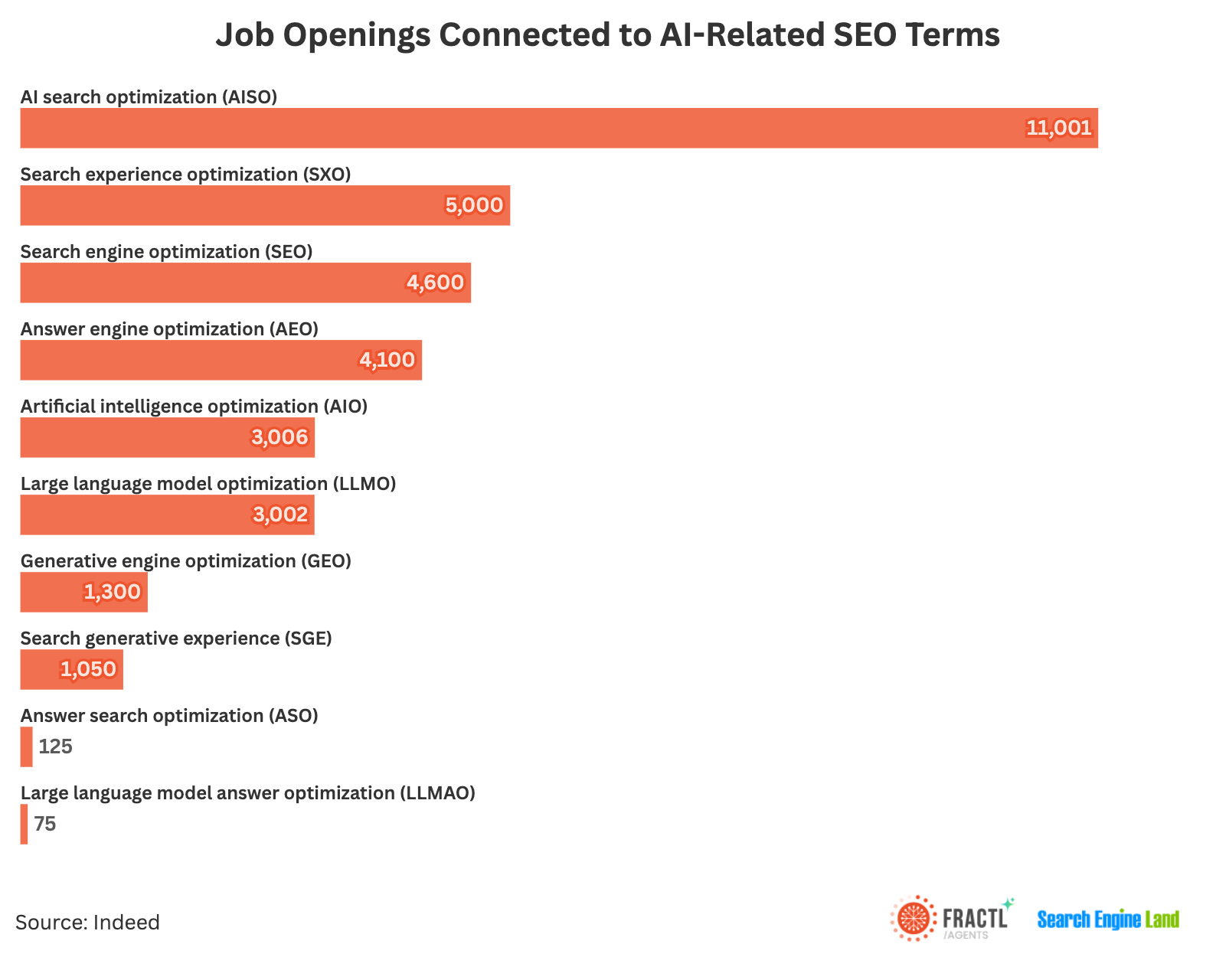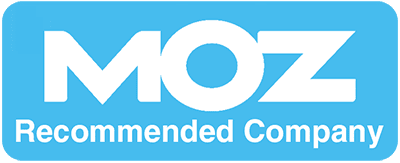The language of search is changing fast. What used to be a world of keywords and backlinks is now full of acronyms like GEO, AEO, and LLMO. Every few months, a new term surfaces promising to define the emerging playbook for driving brand visibility across AI-powered search. As the industry echo chamber booms, even SEOs are struggling to agree on what to call this new branch of search optimization.
At Fractl, we wanted to understand which of these terms were gaining traction among trusted industry peers, so we could communicate effectively with our clients during times of change. As a data-driven marketing agency, we set off to analyze how industry thought leaders were discussing, hiring, and engaging with these concepts across a marketer survey, Google, Indeed, LinkedIn, and Reddit. Our analysis reveals the emerging terms driving brand visibility across AI-driven search and which term will ultimately prevail.
Key Takeaways
- GEO is the mental model, not just a buzzword. It’s the most recognized term and the most used label for GenAI visibility work. However, SEO still anchors the conversation. A meaningful share of marketers default to “SEO” when describing this work, especially in cross-functional settings.
- Generative engine optimization (GEO) continues to surge in Google search volume, great for top-of-funnel education if you define it tightly.
- On LinkedIn, AEO generates the most discussion(comments per post), while Large Language Model Optimization (LLMO) and SXO lead in reach (reactions and shares per post).
- LinkedIn sentiment around these terms is more positive than Reddit sentiment across nearly all new-era terms; SEO sentiment is especially positive on LinkedIn.
- AI Search Optimization (AISO) is the most common job-posting label. Search engine optimization (SEO), Answer engine optimization (AEO), and Search experience optimization (SXO) form the middle tier. GEO and Search Generative Experience (SGE) appear less frequently in job postings and are used more often for project or campaign names.
The Front-Line Reality Check (Marketer Survey)
Before we look at search trends, social engagement, and job postings, we start with the people actually doing the work. While search interest, hiring data, and social chatter indicate what the industry is coalescing, we also wanted to know how working marketers are actually discussing this shift in their day-to-day work. So we surveyed Third Door Media subscribers (people who live inside search and performance metrics) to ask two simple questions:
- Which AI-related SEO terms do you recognize?
- Which term do you personally use to describe optimizing brand visibility across GenAI platforms?

Awareness is not evenly distributed. GEO (Generative Engine Optimization) sits comfortably at the top, with 84% of respondents saying they recognize the term. That tracks with what we see in search interest and thought leadership: GEO has broken through as the shorthand for “the new thing” in search.
Just behind it, AEO (Answer Engine Optimization) and AISEO (Artificial Intelligence Search Engine Optimization) are essentially tied (61% and 60% awareness, respectively). That pairing suggests marketers intuitively gravitate toward language that keeps “engine” and “search” in the frame, rather than completely abandoning legacy mental models. Many of the more “inside baseball” acronyms are still niche; even if they perform well in job postings or thought-leader content, they haven’t landed broadly with practitioners yet.
When we ask, “What term do you use to describe optimizing brand visibility across GenAI platforms?” GEO again leads with 42%. But the next tier is telling: AISEO (16%), SEO (14%), AEO (14%), AIO (11%) and LLMO (8%).
In other words, marketers aren’t abandoning SEO as an organizing idea. Rather, they’re layering GEO, AISEO, and AEO on top of it to describe specific motions in the GenAI stack. GEO is the umbrella concept; AISEO and AEO feel like “how we execute”; SEO remains the backbone that makes the work legible to the rest of the business.
Takeaways:
- GEO is the mental model, not just a buzzword. It’s the most recognized term and the most used label for GenAI visibility work.
- AISEO and AEO are strong “how” labels. They’re well-known and frequently used, making them good candidates for naming campaigns, playbooks, or service lines.
- SEO still anchors the conversation. A meaningful share of marketers default to “SEO” when describing this work, especially in cross-functional settings.
- Most niche acronyms are not client-ready yet. Terms like SXO, LLMO, AISO, and LLMAO may play in specialist circles, but they currently lack broad recognition among practitioners.
This survey gives us the practitioner baseline; the next sections show how that language shows up in search trends, feeds, sentiment, and hiring.
Momentum, Not Just Volume: Which AI-SEO Labels Are Accelerating Right Now in Google Search Volume
Read this like a speedometer, not an odometer. It measures quarter-over-quarter lift to determine the labels gaining velocity right now.

Answer search optimization (ASO) is the fastest riser at 152%, suggesting marketers are actively looking for execution language tied to answer experiences. Because “ASO” is also widely used for app store optimization, spell out the term on first mention to avoid ambiguity.
Generative engine optimization (GEO) is close behind at 121%, reflecting sustained interest in generative-led discovery. Its breadth helps with awareness, but it still benefits from a crisp definition in copy. Artificial intelligence optimization (AIO), an umbrella term that signals broader exploration of AI-driven performance beyond search, grew 99%.
AI search optimization (AISO) at 90% shows healthy momentum for an operational label. This tracks with the hiring language we’ve seen favoring “AI + Search + Optimization” as a framing (more on that below).
Search experience optimization (SXO) rose 70%, while answer engine optimization (AEO) is up 56%. That’s a slower quarter relative to the others, but still a durable, practitioner-friendly term that maps cleanly to how assistants return results.
In practice: If your goal is momentum and awareness, you can ride ASO and GEO right now; just mitigate confusion by spelling out ASO and anchoring GEO with a one-line definition. For implementation and training, AEO and AISO remain the clearest terms to structure playbooks and team charters. Use AIO when you need an umbrella for AI performance beyond search, and keep SXO for UX-centric programs that span SERP, site, and answer surfaces.
Takeaways:
- ASO is this quarter’s breakout. A strong signal of practitioner intent around answer experiences.
- GEO continues to surge. Great for top-of-funnel education if you define it tightly.
- AIO and AISO show solid mid-tier momentum. Indicating broader AI ops and AI-search execution interest.
- SXO is steadily up. Aligning with UX-first discovery work.
- AEO’s slower QoQ growth doesn’t equal weakness. It remains the most precise label for how assistants answer.
The Social Test: What Actually Travels on LinkedIn
On LinkedIn, total engagement per post shows which terms capture the most attention. This aggregate view of reactions, shares, and comments acts like a leaderboard for what the platform’s professional audience finds most compelling at a glance and worthy of sharing with their networks.
Keep two lenses in mind as you read the ranking: terms that open doors (those with big, skimmable appeal that fuel reactions and shares) versus terms that host conversations (those with strong comment depth that sustain threads and foster learning).

The overall engagement leaderboard concentrates at the top around AEO, with LLMO and SXO forming a tight second pack. That pecking order tells us where to anchor high-visibility posts and campaign hooks. It also aligns with the behavioral patterns we see underneath. Terms like LLMO and SXO tend to over-perform on quick-hit signals (reactions/shares), making them efficient reach accelerators for announcements, event invites, and POV snippets.
Meanwhile, AEO reliably generates discussion depth, so once your post is in the feed, it’s the term that keeps people talking in the comments. AISO threads the needle; its practitioner flavor attracts hands-on marketers who want “how to” details, so it’s a strong choice for posts that aim to convert interest into meaningful dialogue.
Classic SEO lags behind in raw engagement compared to novelty acronyms, but it regains traction when framed explicitly as “SEO with AI” and paired with concrete examples or templates.
In practice: Lead with the leaderboard’s top terms to earn the click and the reshare, then pivot (within the same post or in follow-ups) to AEO/AISO language to deepen the conversation and capture qualified interest.
Takeaways:
- LLMO = social reach. Ideal for awareness posts, webinar hooks, and bylines.
- AEO/AISO = depth. Use when you want comments, Q&A, and practitioner dialogue.
- SEO content should evolve, not vanish. “SEO with AI” angles can revive engagement.
The Temperature Check: How Positive Is the Room by Platform?
Sentiment matters. Launching a new term on the wrong platform can stall adoption, while introducing it in the right place can accelerate understanding.
Comparing tone across platforms helps you decide where to debut new ideas and where to test and refine them before scaling. Here’s how new era search terms performed on LinkedIn versus Reddit based on post sentiment.

LinkedIn is consistently more positive than Reddit for nearly all terms. For example, AISO performs especially well on LinkedIn (90.9% positive) but much lower on Reddit (46.8% positive). That doesn’t make Reddit a bad option; it simply serves a different purpose.
LinkedIn functions as the optimistic launchpad for ideas, where professionals tend to embrace emerging terminology and share practical use cases. Reddit, on the other hand, acts as the stress test. Its technical and builder audiences hold terms to a higher standard, surfacing flaws, inconsistencies, or unclear definitions before they reach a broader market.
In practice: Launch new terminology on LinkedIn to build awareness, then test and refine it on Reddit before scaling your message.
Takeaways:
- LinkedIn = launch platform. Start here to generate awareness and adoption.
- Reddit = feedback loop. Use it to clarify definitions and improve messaging.
- AISO shows the most positive sentiment on LinkedIn. But every term except LLMAO performs better on LinkedIn.
- Sequence matters. Introduce, test, refine, relaunch.
The Labor Market: What Hiring Managers Actually Post
Job postings offer a real-time view of how companies are staffing for the AI era. What hiring teams include in these listings is often a leading indicator of how executives plan to resource the work ahead.
Interpreting this view means identifying which terms dominate, which fall into a viable middle, and which companies rarely use — because those absences signal what not to call a role if you want qualified applicants to find it.

AISO dominates job postings with about 11,000 related openings across the United States. This is a clear signal that hiring managers prefer AI search optimization framing the most when seeking workers with these skills.
SXO, SEO, and AEO cluster in a healthy middle tier (at 5,000, 4,600, and 4,100 postings, respectively), indicating sustained demand for UX-aware and answer-aware skill sets that speak to changed discovery patterns in search. AIO and LLMO-related roles appear in about 3,000 postings each.
Hiring managers used GEO and SGE less frequently in Indeed job postings, which is a strong hint to keep them as program or initiative names rather than job titles. ASO and LLMAO appear rarely and should be avoided in hiring language.
In practice: To attract the right candidates, teams should post roles using AISO or SEO (with AI skills clearly listed) and describe day-to-day responsibilities using AEO or SXO terminology within the job description.
Takeaways:
- AISO is the job-market favorite. Referencing “AI search optimization” in job titles or descriptions improves candidate match.
- SEO is still core headcount. Don’t retire the term; reframe it with AI-era skills.
- GEO is not a job family (yet). Use it in thought leadership, not hiring.
What This Means for Teams (Playbook)
Put simply: pick one primary label per objective and design your touchpoints around it. When the goal is education and awareness, GEO earns attention; when the goal is execution and training, AEO and AISO do the heaviest lifting; when the audience is technical, LLMO reliably opens doors. Our marketer survey reinforces this split: GEO is the default mental model for “GenAI-era search,” while AISEO/AEO show up most often as the labels practitioners use to describe the actual work.
Relate job roles to AISO or SEO (+ AI) for discoverability and describe responsibilities with AEO/SXO-style language so candidates recognize the work. Engineer content to its metric: if you need reactions and shares, start with LLMO or SXO; if you want thoughtful comments and practitioner Q&A, anchor on AEO and AISO; if you’re maintaining your SEO foundation, modernize it by demonstrating AI-augmented tactics and outcomes. For client-facing and cross-functional communication, favor the terms our survey shows marketers already recognize (GEO, AISEO, AEO, and plain “SEO”) and treat niche acronyms like LLMO or SXO as supporting language, not the headline.
Instrument sentiment as you go: introduce on LinkedIn, invite critique on Reddit, incorporate what you learn, and then codify the updated language back on LinkedIn for executive and hiring audiences. Revisit your chosen labels at least annually as practitioner usage shifts; the survey results give you a baseline, but the “right” term for your team should evolve alongside how the broader marketing community actually talks about this work.
To ground this guidance in the broader industry conversation, it’s worth ending on how one of the most trusted technical SEOs in the AI era is framing the stakes. In her MozCon talk, Lily Ray puts it plainly:
“The reality is that LLMs use RAG to power AI search. The reality is that GPT-5 is even more reliant on search… Without grounding in RAG, this model is virtually useless. It’s designed to be the brain on top of tools and information it’s provided with, which really implies that SEO has never been more important than it is now, because in order to appear across these different LLMs, you need to appear in search engines first.”
Our data echoes that perspective: no matter which acronym you choose (GEO, AEO, AISEO, AISO, etc.), the brands that win in AI search will be the ones that treat naming as a communication tool, not a distraction from the core job of showing up, consistently, in the underlying search results that LLMs still depend on.
Methodology
For this study, we leveraged a survey, Google Trends via Glimpse, Indeed, LinkedIn, and Reddit to understand the increase in popularity of newly relevant marketing and search terms. We analyzed the increase in search volume, related job openings, and public sentiment across LinkedIn and Reddit to see which terms define this era of search. Specifically, we did the following:
- Survey: We surveyed 342 members of the Third Door Media newsletter about which AI-related SEO terms are most known and used in relation to optimizing brand visibility with Gen AI.
- Glimpse: We analyzed the increase in search interest of AI-related SEO terms in their long form over the last quarter. Data was collected on October 21st, 2025.
- Indeed: We analyzed the number of jobs appearing based on the abbreviated and long form versions of each term; the job title didn’t necessarily have the term in its name. This data was collected on October 8th and in total, included over 33,250 jobs across the US.
- LinkedIn: We scraped over 6,400 posts from August 2025 to October 2025 mentioning either the abbreviated or long form versions of each term, and leveraged the Vader sentiment analyzer to understand the percentage of positive sentiment posts.
- Reddit: We conducted a global scrape, yielding over 3,350 posts from August 2025 to October 2025 mentioning either the abbreviated or long form versions of each term, and leveraged the Vader sentiment analyzer to understand the percentage of positive sentiment posts.
About Fractl
Fractl is a growth marketing agency that helps brands build authority through educational content and newsworthy, data-driven campaigns that earn high-quality brand mentions and drive brand visibility across search, social, and generative AI platforms.
Our client campaigns have been featured in high-authority publications, including The New York Times, The Wall Street Journal, and Harvard Business Review. With over a decade of experience, we’ve helped clients across industries achieve measurable growth in brand visibility, engagement, and conversions.
Fractl is also the team behind Fractl Agents, where we’re publicly beta testing AI tools and agentic workflows that scale our proven processes. We’re at the frontier of generative AI, ensuring your brand stays visible in the next era of search.
Fair Use Statement
If you’d like to reference or republish findings from this study, please cite Fractl and link back to the original report. For press inquiries or bespoke cuts (by vertical or region), contact our team.






